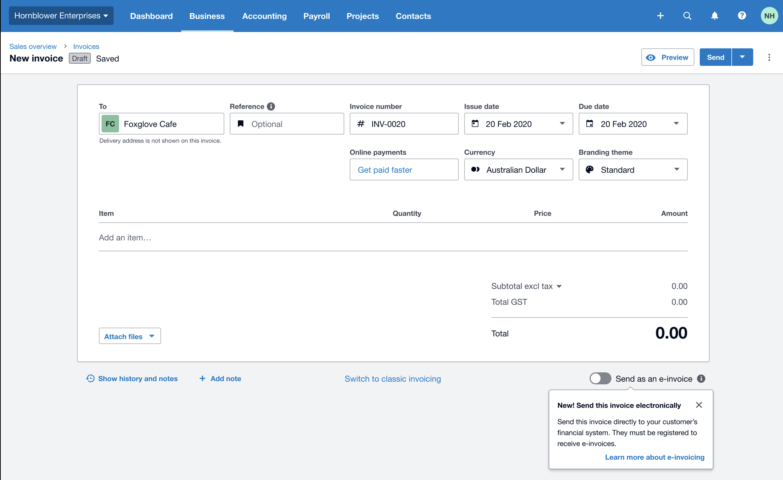E-invoicing has been touted as a way for small businesses to simplify their bookkeeping, by providing a fast, secure and more efficient way to send and receive invoices. However, wide-spread adoption will rely on governments and big business leading the way. Here’s where e-invoicing currently stands at a global level, and why we’re working with the big end of town to support faster payments for our small business customers.
What is e-invoicing?
Right now, there are many ways you can create and send invoices to your customers. You may use Xero to create the invoice and send the PDF via email, or use a word processing software like Microsoft Word and post a hard copy in the mail. No matter how you do it, in most cases your customer still needs to open the invoice when it’s received and enter the data into their accounting system.
This manual process can lead to significant errors, such as entering the wrong amount or bank account, or sending the invoice to the wrong contact in the organisation. This can force you to spend valuable time chasing customers for payment and lead to cash flow issues in your business.
E-invoicing is designed to reduce errors and delays, by sending your invoices directly to your customers’ accounting system. This means you can send your invoice from Xero and it will arrive in your customer’s accounting system as a pre-populated bill, ready to be approved and paid. They won’t have to check their emails or manually enter your invoice into their system.

E-invoicing adoption starts at the top
While the adoption of e-invoicing has been slow and steady over the past few years, it has accelerated as more countries around the world accept it as a best practice (and sometimes mandatory) standard. The United Kingdom and Europe have been rolling out mandatory e-invoicing standards since 2008, while Singapore began encouraging businesses to register for e-invoicing last year. Other markets like the United States and India are in the process of exploring national e-invoicing frameworks.
The global accessibility of e-invoicing means governments are also using it as a way to digitise trade. Singapore has signed an agreement to work with Australia on a number of digital initiatives, including e-invoicing, while the Australian and New Zealand Governments have signed an agreement to use e-invoicing as a means of creating a seamless Trans-Tasman business environment. This has the potential to transform global trade, creating a fast and secure way to invoice across borders.
There’s no doubt that getting governments and big businesses to adopt e-invoicing will be the key to its success. As notorious late payers, large organisations have often struggled to automate their accounts payable process as quickly as small businesses, due to the sheer number of vendors they use and the absence of an invoicing network that connects them to their enterprise software solution. E-invoicing gives these organisations an opportunity to reduce inefficiencies and manual processes, resulting in faster and more accurate payments to suppliers.
Over time, it’s believed that market pressure will encourage more organisations – including telcos, gas and electricity providers – to get on board. Once these organisations begin implementing e-invoicing, there will be a knock-on effect to their small business customers and suppliers. This is when you’ll start reaping the benefits – spending less time chasing payments and manually entering bills into Xero, and more time focusing on your business.
Making the most of our global footprint
Xero has been investing in e-invoicing for a number of years, as part of our focus on digitising small businesses to help them become more efficient and get paid faster. As a global platform, we’ve been working closely with governments, industry and regulatory bodies around the world to advocate for small businesses and support a standardised approach to e-invoicing. This ensures it’s a seamless experience for our customers and partners, no matter where they are in the world.
If you’re in Singapore, you can already send and receive e-invoices in Xero, thanks to our integration partner Storecove. This has been a game-changer for our Singapore customers, as they can now send invoices to customers that are registered on the e-invoicing network. You don’t need to worry about currency exchange or taxes – once you register for e-invoicing through Storecove, it all happens seamlessly in the background.
We’re now making the most of our global footprint to roll out e-invoicing to other countries around the world. Xero is the first major provider of small business accounting software to introduce e-invoicing in Australia and New Zealand. Our customers can now send e-invoices to participating government agencies in their country. This will be followed by the ability to receive e-invoices from suppliers and eventually, to send and receive e-invoices internationally. The future is bright for e-invoicing and we’re doing everything we can to make sure you benefit from the initiative.
A seamless experience in Xero
As a result of e-invoicing, many businesses will want to switch to cloud-based accounting platforms, as it’s much easier to manage e-invoicing in the cloud than using software installed on a server. In Xero, it’s as simple as clicking a toggle switch when invoicing a customer. We’ve also made sure there’s a strong audit trail in our e-invoicing solution, so you can see where the e-invoice has been sent and when. Best of all, e-invoicing will be included free of charge for Xero customers on starter, standard and premium plans.
While it’s still early days for the adoption of e-invoicing globally, we’re expecting to see significant changes to the way governments and businesses send and receive invoices in the months and years ahead. In the meantime, we’ll be working with the big end of town to make sure our small businesses customers and their advisors can use e-invoicing to enjoy faster payment times and better cash flow.
Leave a Reply